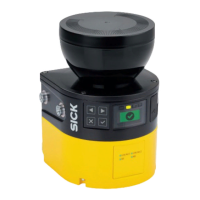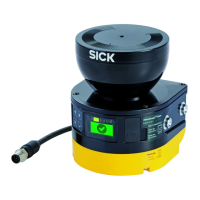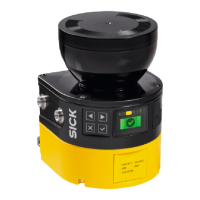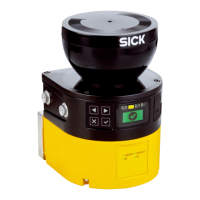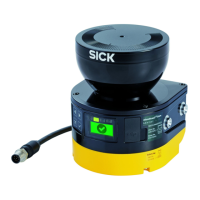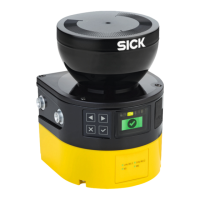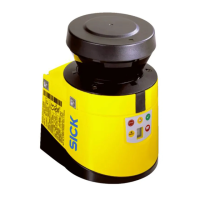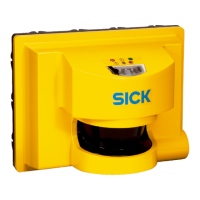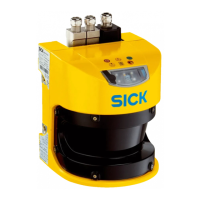Minimum distance to permanently installed structures (e.g. racks)
T
he collision protection field must be at a sufficient distance from permanently instal‐
led structures (e.g. racks) that are located laterally along the travel path. This prevents
the collision protection field from detecting adjacent rack structures when the industrial
truck makes yawing movements.
In order for the collision protection field to cover the entire reference target at all times,
the reference target must have a minimum lateral distance from racks.
Calculation of the minimum distance to permanently installed structures
D
R
T
= (L
CPF
× tan α) + TZ
•
D
RT
= minimum distance of the reference target (outer edge) to permanently
installed structures when the industrial truck is in the center of the track
•
L
CPF
= length of the collision protection field
7)
•
α = maximum yaw angle of the industrial truck including angular resolution of the
safety laser scanner
8)
.
•
TZ = tolerance zone of the safety laser scanner, see "Data sheet", page 165
4.3.10.2.3 Length of the collision protection field
Overview
T
he collision protection field must be designed in such a way that 2 industrial trucks
moving towards each other head-on are braked in good time. The collision protection
field must be long enough to bring both industrial trucks to a standstill under all
conditions before they or their loads touch each other.
Calculation of the length of the collision protection field
L
CP
F
= (2 × L
Stop
) + L
RT
+ L
SLS
+ Z
CPF
•
L
CPF
= length of the collision protection field
•
L
Stop
= maximum stopping distance for the braking mechanism triggered by the
collision protection field including any necessary supplements for brake wear. The
stopping distance must take into account the response time of the safety laser
scanner, the controller and, if necessary, other elements.
7)
•
L
RT
= maximum distance of the reference target to the leading edge of the indus‐
trial truck or load
8)
.
•
L
SLS
= maximum distance from the mounting position of the safety laser scanner
to the leading edge of the industrial truck or the load
8)
.
•
Z
CPF
= supplement to the collision protective field due to the measurement toler‐
ance (100 mm)
Example
•
L
St
op
= 3850 mm
9)
•
L
RT
= 1400 mm
•
L
SLS
= 1200 mm
•
Z
CPF
= 100 mm
L
CPF
= (2 × 3850 mm) + 1400 mm + 1200 mm + 100 mm = 10400 mm = 10,4 m
7)
T
he maximum value of all industrial trucks under all occurring conditions always applies.
8)
The maximum value of all industrial trucks under all occurring conditions always applies
9)
Stopping distance at maximum load = 3500 mm, factor for wear of brakes = 1.1
PROJECT PLANNING 4
8021219/1ELL/2022-01-21 | SICK O P E R A T I N G I N S T R U C T I O N S | microScan3 – PROFINET
59
Subject to change without notice
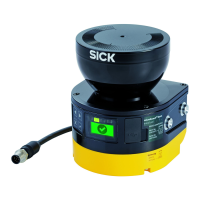
